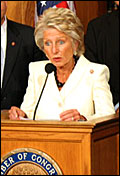Now in her seventh term, Rep. Jane Harman (D-Venice) represents California’s 36th Congressional District.

Even sunny skies and pleasant ocean breezes over much of our state can’t mask the fact that Californians breathe some of the most polluted air in the nation. California is the world’s 12th largest source of carbon dioxide, the chief heat-trapping gas that causes global warming. As dirty as our air is, we are taking the lead nationally in trying to make the air cleaner and our actions greener. Last year, Gov. Arnold Schwarzenegger signed into law ambitious legislation establishing the goal of reducing dangerous emissions to 1990 levels by 2020.
And yet many in Washington, D.C., are unhappy with California’s efforts and are working to undermine and override state laws and regulations designed to reduce greenhouse-gas emissions and promote cleaner fuels.
Several weeks ago, emails from the U.S. Department of Transportation suggested senior-level administrators, and possibly the secretary of transportation herself, have been lobbying on behalf of automobile interests to persuade the EPA not to issue a waiver allowing California’s clean-air rules.
Currently, the Bush administration and Gov. Schwarzenegger are at odds over whether California can do its part to regulate greenhouse-gas emissions from vehicles. Sixteen other states have either adopted or are planning to adopt the California standard, so if the U.S. EPA grants the waiver, it would directly impact 40 percent of the U.S. auto market. In April, Schwarzenegger sent a letter to the EPA giving them six months to act on his waiver before he would be forced to file a lawsuit. Six months have now passed, and the EPA has still not made a decision. Not one to make an empty threat, Schwarzenegger’s administration filed suit today demanding that the EPA make a decision on the waiver.
It is unclear how this standoff will end, and whether the Bush administration will allow California the leeway to regulate its own emissions. Fortunately, the feds cannot impede a growing effort to address global warming now underway at the local level: the “Cool Cities” program.
Begun in 2005, this exciting program is an effort by local communities to pick up where federal and state governments have left off. Cities across the country become “cool” by signing onto the U.S. Mayors’ Climate Protection Agreement — a pledge by mayors to reduce greenhouse-gas emissions in their cities by 7 percent below 1990 levels by 2012.
In just two years, more than 500 mayors from all 50 states representing 66 million Americans have signed on. This includes over 120 cities and several counties in California that are now "cool," such as the cities of Sacramento, West Sacramento, Davis, Nevada City, and Stockton, and the counties of Sacramento and Yolo. Mayors of some of our state’s largest cities, such as Los Angeles, Long Beach, San Francisco, and Fresno, have also signed on, and small communities across the state are joining as well. They, too, see the benefit of programs that can make their towns more energy efficient, help conserve water, promote green buildings, and encourage transportation alternatives.
In Mendocino County, for instance, the town of Willits, with just 5,000 people, is building one of the first "green" hospitals in California, with innovations such as an organic "farm" to provide food for the hospital kitchen. And Hermosa Beach, with just 18,000 residents, is exploring wind energy and considering powering their lifeguard stations with, what else, solar energy.
Along the South Bay of Los Angeles County, the growing number of cities going green has led to the creation of a true Cool Cities partnership, the South Bay Green Cities Task Force. This coalition is providing member cities the opportunity to learn from each other about green programs that work. By pooling resources, its cities can purchase green products together at a lower rate than if they were purchased separately, and establish uniform policies across the region. Uniform standards lessen confusion for residents, reduce costs for businesses, and make it easier to curb harmful emissions.
Gov. Schwarzenegger, who has already shown his commitment to reducing California’s carbon footprint, should promote local and regional efforts to join the Cool Cities program and adopt green practices in their communities. Wouldn’t it be great if in five years every city was a Cool City, making California a “Cool State” at both the state and local level?
Make no mistake: these remarkable local efforts do not let the federal government off the hook. The Bush administration should issue the waiver so states can do their part. In addition, Congress is working on an energy bill to raise fuel-efficiency standards, provide incentives for renewable-energy usage, and foster innovation in alternative energy technologies.
But good things are happening at the local level. Many California cities are implementing new programs and giving residents new tools to save money, improve their quality of life, and do something good for the planet. The challenge is for more of the state’s cities, counties, and regions to join the effort.
That would be cool, wouldn’t it?



